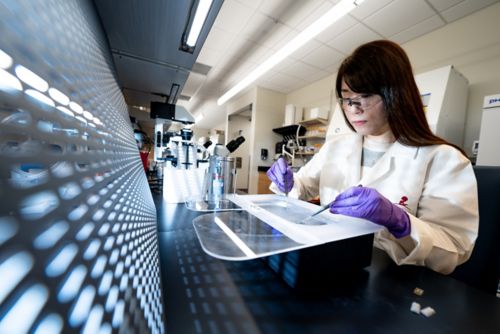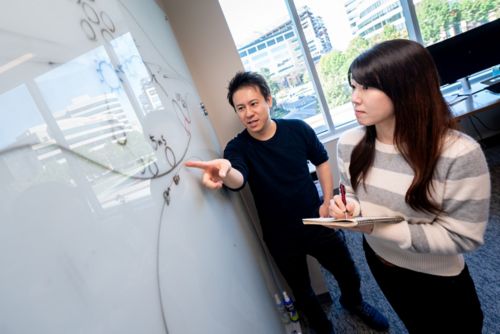St. Jude Family of Websites
Explore our cutting edge research, world-class patient care, career opportunities and more.
St. Jude Children's Research Hospital Home

- Fundraising
St. Jude Family of Websites
Explore our cutting edge research, world-class patient care, career opportunities and more.
St. Jude Children's Research Hospital Home

- Fundraising
Yuuta Imoto Lab
Investigating synaptic membrane and protein dynamics with millisecond temporal and nanometer spatial resolution.
About the Imoto lab
Our laboratory uses a combination of cutting-edge microscopy techniques including time-resolved electron microscopy, cryo-electron microscopy, super-resolution microscopy and genetic engineering to decipher the molecular mechanisms sustaining synaptic transmission. We are particularly focused on understanding how synaptic vesicles are recycled on a millisecond timescale and within nanometer spaces. Our findings provide insights into the basic molecular mechanisms of synaptic transmission, helping us understand what drives healthy brain function and what molecular defects contribute to human neuronal disorders such as epilepsy, autism and Down syndrome.

Our research summary
At the heart of brain function are neuronal synapses. Healthy neuronal communication is dependent upon the quick release of neurotransmitters, stored inside synaptic vesicles (SVs), into the synaptic cleft. This release, mediated by SV fusion with the plasma membrane, consumes over 100 SVs in less than a second. The loss of SVs is rapidly compensated by endocytic retrieval of SV components from the plasma membrane followed by SV regeneration. Any failures in this SV recycling process lead to impaired neurotransmission, as seen in various neuropathological conditions. Despite its biological and pathological importance, the molecular mechanisms of SV recycling have remained unclear for over 40 years due to two technical challenges. First, the synaptic compartment is smaller than the diffraction limit of optical microscopy (less than 200nm), making it difficult to localize proteins. Second, conventional electron microscopy lacks the temporal resolution to capture the rapid SV endocytosis, which is completed within 100ms.
Our laboratory addresses these challenges by combining super-resolution microscopy and time-resolved electron microscopy techniques to investigate how neurons rapidly recycle SV components, how abnormal SV proteins are sorted during neuronal activity and how synaptic structures in modern animals were shaped thorugh nervous system evolution.

Decoding the Dynamin Code: Splice variants in synaptic function and disease
The fastest pathway for SV recycling, known as ultrafast endocytosis, occurs within 100ms after neurotransmitter release. This is 100-fold faster than the textbook mechanism, clathrin-mediated endocytosis. Despite these vastly different kinetics, both pathways share the same regulatory genes. It has remained unclear how the same genes can mediate such a wide range of speeds.
Using time-resolved electron microscopy, we identified that ultrafast endocytosis is mediated by a brain-enriched splice variant of a membrane pinchase called dynamin (Dyn1xA). Super-resolution microscopy techniques, including gated-Stimulated Emission Depletion (gSTED) microscopy, revealed that Dyn1xA and other endocytic proteins form molecular condensates in presynapses to concentrate these proteins. This structure accelerates endocytic kinetics by 100-fold.
As exemplified by Dyn1xA, alternative splicing would be a key regulator for rapid synaptic function. Brain tissue expresses over 30 different combinations of dynamin splice variants in response to different neuronal activities, developmental stages and likely specific neuronal subtypes. Our lab focuses on deciphering the 'Dynamin code'—the puzzle pieces of splicing regions that allow neurons to adapt to a wide range of brain functions.
Our findings have translational potential as some human diseases such as Down syndrome, epilepsy and autism are associated with abnormal SV recycling. In fact, specific Dynamin exons exhibit mutations that are associated with these neuronal disorders. Being able to pinpoint the proteins responsible for affecting these processes gives researchers targets to consider for therapeutic purposes.

Sorting of SV proteins
The high frequency of synaptic transmissions leads to an accumulation of old and/or damaged synaptic vesicle proteins. The overall health of the neuron depends on its ability to identify, isolate and deliver these aberrant proteins to the cell body for degradation. Our laboratory is interested in deciphering the molecular underpinnings driving this process. A key organelle for sorting damaged proteins is the late endosome. While traditional models suggest that late endosome maturation takes more than five minutes, we observe the appearance of late endosomes as early as 10 seconds after neurotransmitter release. To investigate molecular mechanisms of this rapid maturation in presynapses, we use time-resolved electron microscopy and gSTED microscopy, combined with genetic engineering. This approach allows us to directly observe membrane dynamics during endosomal maturation with millisecond precision and localize proteins on 100-300 nm diameter endosomes within presynapses. These insights help us understand how abnormal synaptic vesicle proteins are sorted in both healthy and pathological conditions.
Evolution of a complex neuronal system
Modern animals have well-established centralized nervous systems, enabling complex behaviors and cognitive functions, including learning and memory formation. In contrast, our common ancestors such as cnidarians exhibit simpler nervous system networks and low-frequency neurotransmission, but they already possess similar sets of genes related to synaptic formation and SV release as found in mammals. However, genes involved in rapid SV recycling, including dynamin splice variants, only emerged in the earliest species with centralized nervous systems.
Our laboratory investigates how these early, rapid SV recycling genes contributed to the establishment of modern synaptic structures and functions. To address this question, we apply advanced microscopy techniques and genetic engineering in various bilaterian and non-bilaterian organisms.
Publications
About Yuuta Imoto
Dr. Imoto received a PhD in cell biology from the University of Tokyo in Japan. He then trained as a postdoctoral fellow in the laboratory of Yukio Fujiki, PhD, at Kyushu University and in the laboratory of Shigeki Watanabe, PhD, at Johns Hopkins School of Medicine. In 2024 Dr. Imoto joined the St. Jude faculty as an Assistant Member in the Department of Developmental Neurobiology. His work focuses on understanding the process of synaptic membrane fission and the development of experimental techniques that allow for its visualization.

The Team

- Chelsy Eddings, PhD
- Postdoctoral Research Associate

- Kie Itoh, PhD
- Scientist
Contact us
Yuuta Imoto, PhD
Assistant Member, St. Jude Faculty
Department of Developmental Neurobiology
Room M2414
St. Jude Children's Research Hospital
Follow Us

Memphis, TN, 38105-3678 USA GET DIRECTIONS


